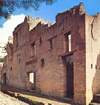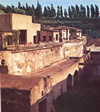 Typical example of House at Herculaneum.
Typical example of House at Herculaneum.On the Southern side of Ancient Hercolaneum, sumptuous houses with a splendid view line up, and next to this rich dwellings other smaller houses rise too, indication of some variety as regards the economical and social condition of the population. Besides this house in Hercolaneum has two upper floors, accessible by stairs, and rooms lighted with windows looking over the street: the structure has more than one accommodation and it is one of the most ancient examples of immovable unit.
 Photo of the "Casa dell’Atrio a Mosaico" and The "House of the Deer "
Photo of the "Casa dell’Atrio a Mosaico" and The "House of the Deer "According to the legend, this Greek settlement was founded by Hercules (hence the name). Whatever the thruth of this, it later passed to the Samnites before becoming a Roman town. The fate of the city paralleled that of the nearby Pompeii. Destroyed by the earthquake in 63 AD, it was completely submerged in the 79 AD eruption of Mt Vesuvius. The difference was that Herculaneum was buried by a river of volcanic mud , not the pumice stones and ash that rained on Pompeii.
 Some of the most sumptuous houses of Hercolaneum
Some of the most sumptuous houses of HercolaneumRediscovered in 1709, amateur excavations of Herculaneum were carried out intermittently until 1874 and much of the artefacts found was carted off to Naples to enrich the Royal Museum. Serious archaelogical works began in 1927, but the excavations are still nowadays. On entering in Herculaneum, You find first of all the Casa d’Aristide. Immediately next door is the Casa d’Argo, a well preserved example of a Roman noble family’s house, equipped with a porticoed garden , triclinium ( dining area) and a partly excavated peristyle hall.
 A particular of the columns of the house on Decumano Massimo.
A particular of the columns of the house on Decumano Massimo.Thanks to careful excavations the archaelogists have found some wooden parts of the building, the shutters of the windows and the jamb of the doors. The streets in Herculaneum rarely had ruts worn by wheels of heavy carts. There were no stepping stones so that pedestrians' feet were kept dry, like in Pompeii. The town of Herculaneum had an excellent drainage system. An underground system carried rainwater and wastewater out to sea. Herculaneum was a cleaner and quieter town than Pompeii.
 One of the ancient fountains on Decumano Massimo.
One of the ancient fountains on Decumano Massimo.The site is divided into 11 islands or insulae, according to the classic Roman grid pattern. The two main streets, the Decumani, are crossed by several cardos. Herculaneum is thought to be the "town of Hercules". People say that Hercules created the town while coming back from Spain. The town of Hercules is on the shore of the Bay of Naples, and is just a few miles away from the volcano, Mount Vesuvius. Thousands of years ago, this volcano erupted and covered Herculaneum with many layers of ashfall which has preserved it through the centuries.
 A view of Casa dei Cervi.
A view of Casa dei Cervi.Accessible from Cardo IV, the House of the Deer is probably the most imposing of the nobles’ dwellings. The villa, built around a central courtyard, is decorated with various frescos and still-life paintings, as well as the marble groups of deer assailed by dogs. In one of the rooms a statue of a drunken Hercules was found (now it is in the Naples Archeological Museum). Herculaneum is unjustly less famous than its bigger neighbour Pompeii as the state of preservation of the buildings are generally much superior. It was buried during the same series of eruptions that destroyed Pompeii, but it was destroyed by a pyroclastic flow (mud) and the timber has survived in a charred condition giving a much better idea of what a Roman town may have looked like.